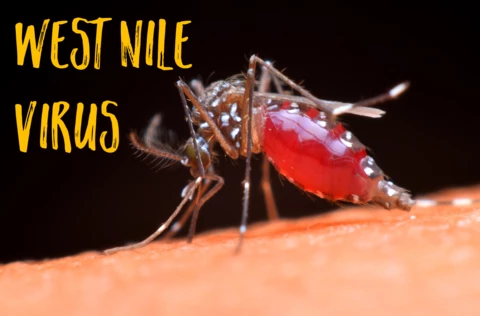Ameen Qudir
Published:2019-09-28 05:44:49 BdST
ডেঙ্গির পর এবার মৃত্যুর বার্তাবাহী নতুন ভাইরাস বাংলাদেশে :ওয়েস্ট নাইল
ডেস্ক
___________________
বাংলাদেশে নতুন একটি ভাইরাস এসেছে বলে মিডিয়াসূত্রে জানা গেছে। ভাইরাসের কারণে স্নায়ুতন্ত্রের রোগে মানুষের মৃত্যু হতে পারে। আক্রান্ত মানুষের ৮০ শতাংশের রোগের কোনো লক্ষণ দেখা যায় না। আক্রান্ত ৮০ শতাংশ মানুষের শরীরে কোনো রোগের লক্ষণ দেখা দেয় না। আক্রান্ত ২০ শতাংশের ওয়েস্ট নাইল জ্বর হয়। এর লক্ষণ হচ্ছে জ্বর, মাথাব্যথা, পরিশ্রান্তভাব, শরীরে ব্যথা, বমিভাব, মাঝেমধ্যে শরীরে র্যাশ দেখা দেয়।নতুন ভাইরাসে সংক্রমিত মশা কামড়ালে মানুষ আক্রান্ত হয়। আক্রান্তদের ৮০ শতাংশের রোগের কোনো লক্ষণ দেখা যায় না। এ বিষয়ে বিশেষজ্ঞ গবেষণাসহ বিস্তারিত তথ্য প্রকাশ হল। প্রথমে ঢাকার মিডিয়ার তথ্য।
প্রথম আলো তে প্রকাশ রিপোর্টে জানা যায়,
কোথা থেকে এই ভাইরাস এসেছে, সরকারি তরফ থেকে তার অনুসন্ধান এখনো শুরু হয়নি। কতজন মানুষ এই ভাইরাসে আক্রান্ত, তা–ও জানা যায়নি। রিপোর্টটি লেখেন শিশির মোড়ল। তিনি লেখায় জানান,
ভাইরাসের নাম ‘ওয়েস্ট নাইল ভাইরাস’। সংশ্লিষ্ট সরকারি ও বেসরকারি বিজ্ঞানী, গবেষক ও কর্মকর্তারা বলেছেন, ভাইরাসটি বাংলাদেশে নতুন। আন্তর্জাতিক উদরাময় গবেষণা কেন্দ্র, বাংলাদেশ (আইসিডিডিআরবি) একজন ব্যক্তির শরীরে এই ভাইরাস শনাক্ত করেছে। সপ্তাহ দেড়েক আগে আইসিডিডিআরবি এই তথ্য লিখিতভাবে সরকারের অন্তত তিনটি দপ্তরকে জানিয়েছে বলে সরকারি সূত্রগুলো নিশ্চিত করেছে। তবে আইসিডিডিআরবি কর্তৃপক্ষ এ বিষয়ে কোনো তথ্য বা বক্তব্য দিতে অস্বীকৃতি জানিয়েছে।
জাতিসংঘের একটি বিশেষায়িত সংস্থার একজন পরামর্শক বলেছেন, ঢাকার অদূরে যে এলাকায় এই রোগী শনাক্ত হয়েছে, সেখানে জরিপ করলে আরও রোগী পাওয়া যেতে পারে। সময়ক্ষেপণ না করে কাজটি করা উচিত।
সরকারি সূত্রগুলো বলছে, স্বাস্থ্য অধিদপ্তরের রোগনিয়ন্ত্রণ শাখা, হাসপাতাল শাখা এবং রোগতত্ত্ব, রোগনিয়ন্ত্রণ ও গবেষণা প্রতিষ্ঠানকে (আইইডিসিআর) চিঠি দিয়েছে আইসিডিডিআরবি।
বিশ্ব স্বাস্থ্য সংস্থা বলছে, ওয়েস্ট নাইল ভাইরাস সাধারণত কাকজাতীয় পাখির শরীরে সুপ্ত অবস্থায় থাকে। এই ভাইরাসে সংক্রমিত মশা কামড়ালে মানুষ এতে আক্রান্ত হয়। ভাইরাসের কারণে স্নায়ুতন্ত্রের রোগে মানুষের মৃত্যু হতে পারে। আক্রান্ত মানুষের ৮০ শতাংশের রোগের কোনো লক্ষণ দেখা যায় না। আক্রান্ত ঘোড়ায় এ রোগের তীব্রতা বেশি দেখা দেয় এবং ঘোড়া মারা যায়।
রোগনিয়ন্ত্রণ শাখার পরিচালক অধ্যাপক সানিয়া তহমিনা বলেন, ‘আমারা আরও অনুসন্ধান করার জন্য আইইডিসিআরকে বলব। এরপর আমরা করণীয় ঠিক করব।’
অনুসন্ধানের বিষয়ে রোগনিয়ন্ত্রণ শাখা থেকে আনুষ্ঠানিক কোনো বার্তা পাননি বলে জানিয়েছেন আইইডিসিআরের পরিচালক অধ্যাপক মীরজাদী সেব্রিনা। তিনি বলেন, ‘বার্তা পেলে আমরা ঘটনা যাচাই করব, পরিবারের সদস্যদের পরীক্ষা করব এবং প্রয়োজনে জরিপ করব।’
কোথা থেকে এল
বিশ্ব স্বাস্থ্য সংস্থা বলছে, ১৯৩৭ সালে আফ্রিকা মহাদেশের উগান্ডার ওয়েস্ট নাইল অঞ্চলে একজন নারীর শরীরে প্রথম এই ভাইরাস শনাক্ত হয়। ১৯৫৩ সালে নীল বা নাইল নদ উপত্যকার পাখির (কাকজাতীয়) শরীরে এই ভাইরাস চিহ্নিত হয়।
গত ৫০ বছরে বিশ্বের অনেক দেশে এই ভাইরাসে মানুষ আক্রান্ত হয়েছে। সবচেয়ে বড় প্রাদুর্ভাব দেখা দেয় গ্রিস, ইসরায়েল, রুমানিয়া, রাশিয়া ও যুক্তরাষ্ট্রে। প্রাদুর্ভাব দেখা গেছে এমন এলাকাগুলো পরিযায়ী পাখির বড় কোনো চলাচলের পথ নয়। আফ্রিকা, ইউরোপের কিছু অংশ, মধ্যপ্রাচ্য, পশ্চিম এশিয়া ও অস্ট্রেলিয়ায় এই রোগের সংক্রমণ দেখা দেয়।
নতুন ভাইরাসে সংক্রমিত মশা কামড়ালে মানুষ আক্রান্ত হয়। আক্রান্তদের ৮০ শতাংশের রোগের কোনো লক্ষণ দেখা যায় না।
১৯৯৯ সালে যুক্তরাষ্ট্রের নিউইয়র্ক শহরে এই ভাইরাস আসে ইসরায়েল ও তিউনিসিয়া থেকে এবং দেশটির বিভিন্ন রাজ্যে এর প্রকোপ চলতে থাকে ২০১০ সাল পর্যন্ত।
যুক্তরাষ্ট্রের রোগনিয়ন্ত্রণ ও রোগ প্রতিরোধ প্রতিষ্ঠান সেন্টার ফর ডিজিজ কন্ট্রোল তাদের ওয়েবসাইটে বলেছে, যুক্তরাষ্ট্রে মশাবাহিত রোগের মধ্যে প্রধান হচ্ছে ওয়েস্ট নাইল ভাইরাস। এই ভাইরাস প্রতিরোধে কোনো টিকা নেই এবং আক্রান্ত মানুষের সুনির্দিষ্ট চিকিৎসা নেই। আক্রান্ত প্রতি পাঁচজনের একজনের জ্বর ও অন্যান্য উপসর্গ দেখা দেয়। আক্রান্ত ১৫০ জনের মধ্যে একজনের পরিস্থিতি তীব্র হয়, মৃত্যুর ঘটনাও ঘটে।
কীভাবে ছড়ায়
বিশ্ব স্বাস্থ্য সংস্থা বলছে, কোনো সংক্রামিত পাখির কাছ থেকে মশা এই ভাইরাস পায়। কয়েক দিনে মশার শরীরে ভাইরাসের সংখ্যা বৃদ্ধি পায়। এরপর ওই মশা কোনো মানুষ বা পশুকে কামড়ালে সংক্রমণ ছড়ায়। এ পর্যন্ত মানুষ থেকে মানুষে সংক্রমণের কোনো ঘটনার নজির দেখা যায়নি। অন্যদিকে মা থেকে শিশুতে সংক্রমণেরও কোনো নজির নেই। মশা নিয়ন্ত্রণই এই ভাইরাস প্রতিরোধের প্রধান উপায়।
রোগের লক্ষণ ও শনাক্ত করা
আক্রান্ত ৮০ শতাংশ মানুষের শরীরে কোনো রোগের লক্ষণ দেখা দেয় না। আক্রান্ত ২০ শতাংশের ওয়েস্ট নাইল জ্বর হয়। এর লক্ষণ হচ্ছে জ্বর, মাথাব্যথা, পরিশ্রান্তভাব, শরীরে ব্যথা, বমিভাব, মাঝেমধ্যে শরীরে র্যাশ দেখা দেয়।
ওয়েস্ট নাইল জ্বর মারাত্মক হলে মাথাব্যথা, তীব্র জ্বর, ঘাড় শক্ত হওয়া—এসব উপসর্গ দেখা দেওয়ার পাশাপাশি মানুষ অজ্ঞান হয়ে যায়, পক্ষাঘাতগ্রস্ত হওয়ার ঝুঁকিও আছে।
অন্তত পাঁচ ধরনের পরীক্ষার মাধ্যমে এই ভাইরাস শনাক্ত করা সম্ভব বলে বিশ্ব স্বাস্থ্য সংস্থা জানিয়েছে। গত সোমবার রাতে একাধিক প্রতিষ্ঠানের সঙ্গে কথা বলে জানা গেছে, দু–একটি গবেষণা প্রতিষ্ঠান ছাড়া এই ভাইরাস শনাক্ত করার প্রযুক্তি কারও কাছে নেই।
নতুন এই ভাইরাস সম্পর্কে বঙ্গবন্ধু শেখ মুজিব মেডিকেল বিশ্ববিদ্যালয়ের সাবেক উপাচার্য ও ভাইরাস বিশেষজ্ঞ অধ্যাপক নজরুল ইসলাম বলেন, ‘নতুন এই ভাইরাস সম্পর্কে বিস্তারিত জানতে হবে। স্বাস্থ্যকর্মীদেরও জানাতে হবে। সবচেয়ে বড় কথা, মশা নিয়ন্ত্রণে জোর দিতে হবে।’
WEST NILE ENCEPHALITIS
West Nile encephalitis
By Professor Tom Solomon, Chair of Neurological Science, University of Liverpool and Katherine Dodd, Specialist Registrar in Neurology and reviewed by Dr James Mitchell, Academic Clinical Fellow
WHAT IS WEST NILE ENCEPHALITIS?
West Nile fever virus was first found in the blood of a person with a high temperature in Uganda in 1937. Since then the virus has been found to be distributed not only in Africa, but also southern Europe, the Middle East, America and even parts of the Far East. The first outbreak in the United States of America (USA) occurred in 1999, in New York. The virus spread throughout the country and in 2002 West Nile virus was declared endemic in the USA.
The virus has since spread across the North American continent into Canada and the Caribbean, although only very few cases have been reported in Latin America. Recently, outbreaks have also occurred in Europe, and in 2016 included Spain, Hungary, Serbia, Austria, Italy, Romania, Ukraine and Spain. Surveillance is currently taking place in the south east of the UK, however, the virus has not been found in any mosquitos in this country.
West Nile virus is an arbovirus. Viruses that are transmitted from one animal host to the next by insects (arthropods) are known as ‘arboviruses’ (arthropod-borne). Viruses comprise small pieces of genetic material (nucleic acid) whose sole purpose in life is to make more of themselves. Because they don’t have all the ability to do this alone, they have to muscle into ‘host’ cells and borrow bits of their machinery. The host develops an immune response to fight off this invasion and the rest follows as a consequence of this eternal struggle.
West Nile virus is transferred mainly between pigeons and crows by ‘Culex’ mosquitoes. People can get infected from the bite of a mosquito that is infected with the virus. The virus is not transmitted from person to person. There is no evidence that a person can get the virus from handling live or dead infected birds. However, it is still recommended that barehanded contact with dead animals is avoided.
SYMPTOMS AND DIAGNOSIS OF WEST NILE ENCEPHALITIS
The time from infection to developing symptoms of West Nile infection is usually 3 - 14 days. Mild infections are common and include a high temperature, headache and body aches, often with skin rash and swollen lymph glands. However, the majority of people who get infected do not have any symptoms at all. Diagnosis is made based on the symptoms and in most cases can be confirmed by urine, blood or spinal fluid tests.
Until recently brain problems after West Nile infection were thought to be rare, however, in recent years the virus is causing different types of disease. Approximately 1 in 100 people infected with the virus will develop brain complications as a result of infection. Encephalitis results when the virus invades the brain causing damage and an inflammation (swelling) response. The symptoms and signs of West Nile encephalitis range from muscle weakness and paralysis, mild confusion and behavioural changes (which may be mistaken for hysteria) to convulsions (fits) and deep coma. West Nile virus encephalitis is associated with considerable short-term and long-term risks of death and significant disability.
TREATMENT AND PREVENTION OF WEST NILE ENCEPHALITIS
There is no specific treatment for the cause of West Nile virus encephalitis. Treatment, in most cases, consists of treating the complications of the disease such as high fever and aches, low blood pressure, blood loss, convulsions (fits), or raised pressure within the skull.
The simplest preventative measure is to avoid bites from the mosquitoes that carry the virus. This means wearing long sleeves and trousers, especially during the evening when the mosquitos bite more frequently and avoiding areas where stagnant water can be found as mosquito larvae need still water to develop. For further protection use an insect spray containing at least 30% DEET (N,N-diethyl-3methlybenzamide) and sleep under bed-nets.
There is no vaccine at present to protect against West Nile virus, although several are being developed and tested.
Future research
Current research is looking at ways to reduce resistance to insecticides used to eradicate mosquitos and develop the best possible treatments for the disease. Treatments that have been tried include anti-viral drugs and drugs that modulate the body’s immune system. It is hoped that a vaccine will soon be available for use, although work needs to be done to ensure that the effects are long lasting and safe. Much research is also being carried out on surveillance of the disease and to try to predict when and where outbreaks are going to happen.
আপনার মতামত দিন:









